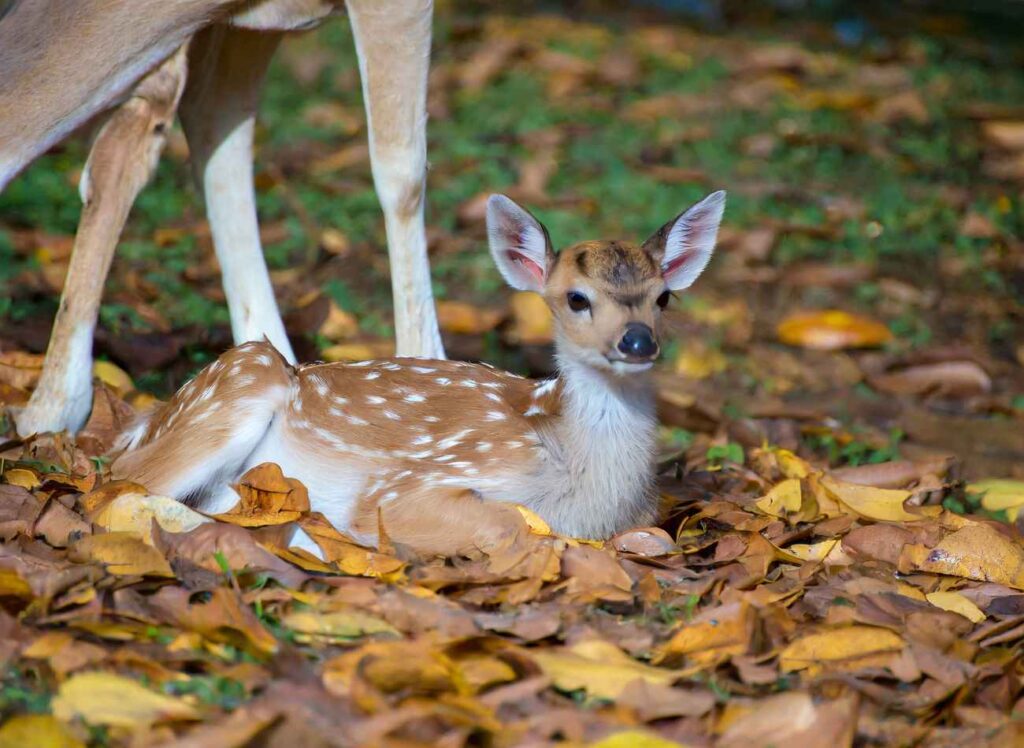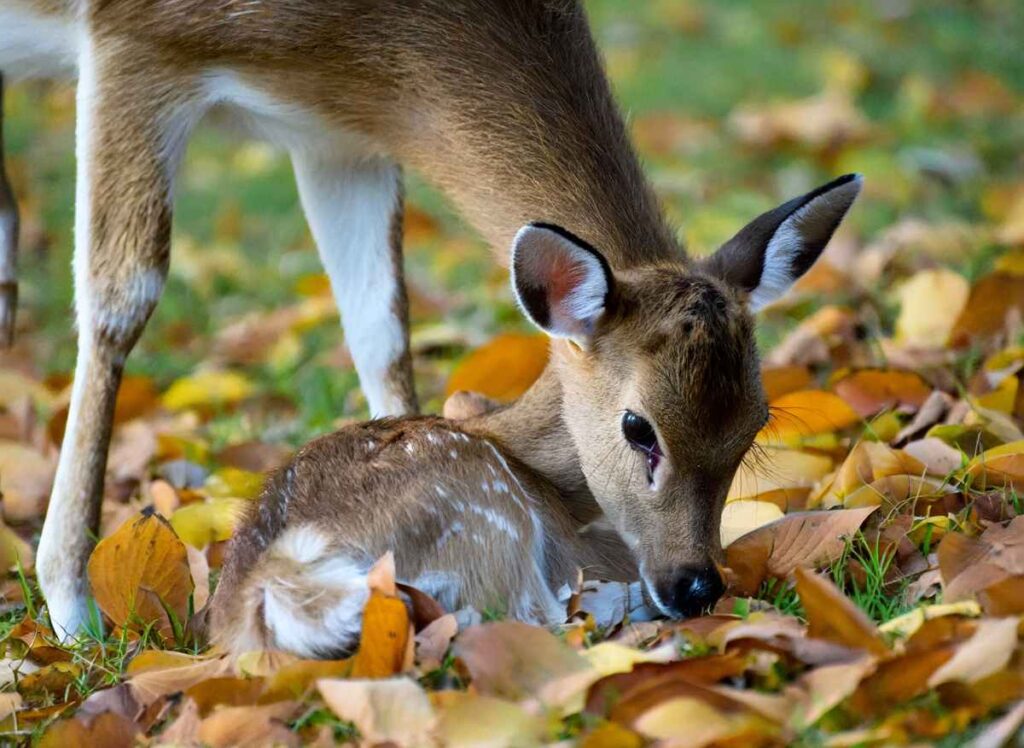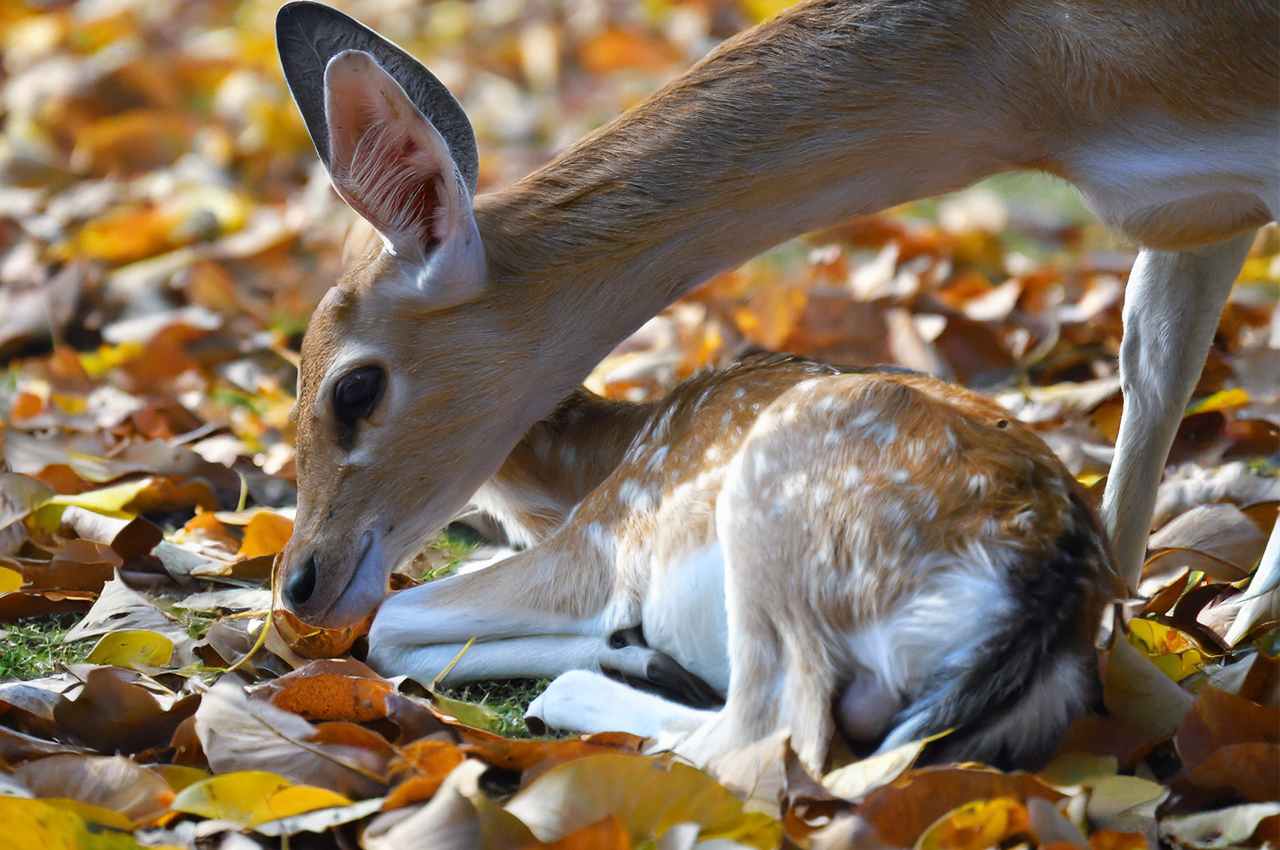Discovering When do Whitetail Deer give birth, involves observing their behavior and habitat during the birthing season. Whitetail deer, native to North America, have a defined breeding season that leads to fawns being born at the optimal time of year to survive and thrive. Knowing the deer reproductive cycle will help you anticipate when to expect to see cute fawn babies in your neighborhood.
Whitetail Deer Birthing Season
Typically, white-tailed deer give birth in the spring, between May and June. Deer give birth at different times depending on their latitude, sooner in the south and later in the north.
Whitetail deer females become pregnant in the fall because they have a 200-day gestation period. The rut, or mating season, for whitetail deer takes place between October and November. Male deer will compete with one another for the attention of females during the rut.
Twins and triplets are also conceivable in the birth of a female whitetail deer, who generally gives birth to a single fawn. Fawns may stand and walk within minutes of birth and are born with their eyes open. At roughly 4 months old, they are weaned from their mothers.
| Key Birthing Information | Details |
|---|---|
| Breeding Season | Late October to the first week of December |
| Peak Breeding Period | Last two weeks of November |
| Gestation Period | 200 days |
| Birth Season | Late May to early July |
| Fawn Birth Period | May 12 through June 25, with the majority born from May 29 through June 10 |
| Fawn Characteristics | Spend most time bedded down, with underdeveloped scent glands |
| Offspring of Adult Does | Usually twins, born within an hour of each other during parturition |
| Number of Offspring | Typically 1 to 3 fawns |
| Newborn Weight | 5-8 pounds |
| Distinctive Features | White spots for camouflage |
| Nursing Period | 4-5 times per day for 4 months |
| Growth Rate | Up to 60-70 pounds in a few months |

Birth Environment and Behavior
- Whitetail deer typically give birth in secluded areas, such as forests or thickets.
- Fawns are born with their eyes open and can stand up and walk within minutes of being born.
Maternal Care and Protection
- The mother deer will stay with her fawn for the first few days to protect it from predators.
- The fawn will stay hidden in the grass or brush for most of the day while its mother goes out to feed.
Development and Maturation
- The fawn will start to follow its mother around at around 2 weeks old.
- Fawns reach sexual maturity at around 18 months old.
Whitetail deer are a crucial component of the ecology because they help spread seeds and regulate the development of plants. They are also a well-liked game animal in several nations.
The Whitetail Mating Season
The rut, often known as the deer mating season, takes place every autumn. The biological reaction of the deer to varying day duration, photoperiodism, causes the time of the rut. Hormonal changes cause the rut to begin when the days become shorter following the summer solstice.
Around the majority of North American locations, whitetails reach their breeding peak around November. The precise time might change depending on the area, the weather, and the makeup of the herd. 1-2 weeks sooner than southern states, the northern states may go through their rut. The frantic rut lasts for two to three weeks.
Bucks engage in fierce competition for breeding privileges during the rut. They wrestle, scratch, and rub trees with their antlers. Once a dominant buck and a doe have successfully mated, the doe is fertilized, and the pregnancy process starts.
Gestation Period for Whitetails
The gestation cycle for whitetail deer lasts for 195 to 205 days. This indicates that fawns will arrive 6-7 months after the doe gave birth.
Because the rut peaks in November, the majority of fawns should arrive in May or June of the following spring. The timing is ideal, with mild weather and plenty of food supplies from springtime flora.
Newborn Fawns
does give birth to one to three fawns, usually twins. Fawns are born weighing between 4 and 8 pounds, and they have white markings to help hide them from predators.

Soon after birth, fawns may stand on shaky legs. They gain coordination and the capacity to outrun danger in a few of weeks. For the first several weeks of their lives, the doe feeds them milk and conceals them in the undergrowth.
Peak Fawning Season
The main fawning season for whitetails is May through June, but a few fawns may be born as early as late April in the southernmost region.
Within a 6-week window from mid-May to late June, more over 80% of fawns are born. The spike coincides with the height of the springtime greenery’s food supply. This gives breastfeeding does and developing fawns nutrition.
Early spring births of fawns expose them to more severe weather conditions. Late summer births provide little time for weight gain before the coming of winter. So the May–June period is helpful from an evolutionary perspective.
Birthing Timeline
The following timeline highlights significant occasions in the whitetail reproduction cycle:
- October-December: Peak rut/breeding season
- November-December: Most does are bred
- Mid April: Earliest fawns born
- May-June: Peak birthing season for 80%+ fawns
- August: Last possible birthing month before unlikely survival

So mark May–June on your calendars if you’re wondering when you’ll next see cuddly spotted fawns munching beside does. However, keep a look out for early and late bloomers as early as April and as late as August. Predicting and enjoying the witnessing of these unique wildlife moments may be made easier by being aware of the whitetail’s breeding and gestation cycle.
Regional Variations
Throughout the vast habitat range of the whitetail, there might be a variance of up to one month in normal birthing dates:
- Northern States and Canada: peak fawning season from late May through early June
- Midwestern States: peak fawning occurs from late May to mid-June
- Southern States: peak fawning period is early May to mid-June.
A modest second fawning flush from late-cycling does may occur in southern locations in July or August. But chances of surviving the winter are reduced by late births.
When to Expect Fawns: Regional Variations
Although the whitetail fawning phase is generally brief across their ecological area, there are regional variations in normal birth dates. Here is a deeper look at the fawn-emergence dates for several regions of North America:
Northern States & Canada
Peak fawning occurs in late May to early June in the northernmost parts of the whitetail range, such as Canada, Maine, Michigan, and Minnesota. Because of the harsher winters, snowmelt and green-up occur later than further south.
On the early end of the general May-June period, they also give birth to fawns. Fawns who were born too early would have a difficult time surviving in the cold. But newborns in late May or early June take advantage of increasing temperatures and spring greenery.
Midwestern States
The main fawning season in the Midwest, which includes Illinois, Iowa, Missouri, and Ohio, lasts from late May to mid-June. Does may give birth a few weeks earlier than their northern counterparts due to milder weather and faster spring plant development.
Between high-quality food plots on private farms and forest/field boundary habitats, the midwestern states provide ideal deer habitat. With an abundance of early summer nutrients, fawns flourish in this area.
Southern States
Fawns come somewhat earlier between early May and mid-June in the southern whitetail range, including states like Georgia, Mississippi, Oklahoma, and Texas. Early births are made possible by warmer regions and practically year-round vegetation.
Southern does may breed beyond February, which can result in some very early April fawns. However, even in the south, the peak 6-week period from May to June sees 80%+ of fawns born.
Caring for Fawns: Do’s and Don’ts
Concern might arise when a fawn is seen sleeping by itself. But in order to prevent upsetting them, it’s crucial to know what to do:
Leave Fawns Alone
For extended periods of time, a doe hides her fawns while she grazes, refuels, and refills her energy and milk supply. The fawn is shielded by its lack of smell and concealment. A concealed fawn runs the danger of being permanently cut off from its mother if someone intervenes.
Don’t Touch Fawns
Fawn handling may spread human smell, which can make a doe reject her young. Always resist the urge to touch, hug, or move fawns and leave them alone where you find them.
Allow Nursing Time
A doe needs enough time to eat before returning to tend to her young. Avoid loud sounds and other activities that can interrupt this important time for bonding and feeding.
Monitor At-Risk Fawns
The only time to step in is if a newborn fawn continues to scream out in the same place for a lengthy period of time, signifying abandonment. Or if a fawn needs rehabilitation because it is bleeding, limping, or having trouble standing. Before approaching or calling wildlife specialists, keep an eye on fawns who are in danger from a distance.
We may wisely cohabit with whitetails throughout the wonderful fawning season if we have an understanding of their requirements and show respect for them. Act responsibly since handling or getting too near to fawns might endanger their health.
10 Surprising Facts About When Whitetail Deer Give Birth
The whitetail’s intricate reproductive cycle helps perpetuate the species:
1. Whitetails are polyestrous; until they get pregnant, they go through numerous estrus cycles each year. This raises the likelihood of conception.
2. Dominant bucks may mate with multiple does at the height of the rut, but they do not stick with any one partner. Up until the mating season is through, bucks are mostly focused on the rut.
3. Fawns are able to walk within 30 minutes of birth, but they don’t develop smell for the first week or two to hide from predators.
4. Fawns double in weight within two weeks after birth, weighing just 4 to 8 pounds at birth. They grow quickly on milk.
5. Does begin breeding as yearlings at the age of 16 to 18 months. More frequently than not, young does give birth after mature does.
6. Whitetails practice synchronizing their estrous cycles. During the peak of the rut, numerous does that cycle together come into heat all at once, resulting in synchronized birthing seasons.
7. During estrus, does employ calls, posture, and odors to draw buck attention. When ready to breed, they show receptivity.
8. Preparing the ground and trees for breeding via rutting activities. In order to attract mates, scraping distributes pheromones and odors.
9. Does will nurse their fawns for about 4 months, but the fawns will start to eat solid food at around 2 weeks old.
10. Does can give birth at any time of day or night, but they are most likely to give birth at dawn or dusk.
The distinctive reproductive methods and adaptations of the whitetail are essential to their healthy populations in a variety of habitats.
Frequently Asked Questions
When do most whitetail deer give birth?
Whitetail deer often give birth in May and June. In the peak 6-week period from mid-May to late June, more over 80% of fawns are born. This is also when the weather is at its best and there are plenty of springtime plant food sources. Fawns have the highest chance of surviving and growing quickly at this time.
How can I tell if a whitetail doe is pregnant?
An expanded or bloated tummy in the winter or early spring, observable fawn movement, darker teats and bigger mammary glands as labor approaches, increased hunger, and weight gain are all indicators that a whitetail doe is pregnant. Other behavioral changes include seeking out quiet spaces and being more vigilant or hostile.
Do whitetail does give birth at night?
Whitetail does often give birth during night and in the shadows. This aids in protecting young fawns from possible daylight predators. Giving birth at night and leaving the fawns in their bedding and concealment during the day is an efficient survival tactic.
How often do whitetail deer give birth to twins or triplets?
Whitetail does sometimes give birth to one or two fawns, but twins are more typical. Around 10% of births result in triplets, which are neither uncommon nor uncommonly frequent. Increased possibilities of several fawns result from good diet. Twins or triplets are more likely to be born to older does than to younger ones.
What month do the latest whitetail fawns get born?
Even though May and June are when most births occur, some calves are born far into the summer. Before winter, when survival becomes very improbable, August is the last month for newborns. Only 2% of fawns are born after August 2nd, however.
Can a six month old doe get pregnant and birth a fawn?
Although it is uncommon, it is conceivable. Around 16 to 18 months old, the majority of whitetail does achieve sexual maturity and give birth to their first fawn. However, late-born does from the prior year may enter estrus and mate when they are 6 months old, resulting in a few very uncommon early newborns.
How can you tell a newborn whitetail fawn's age?
Fawn babies have short, silky hair. Their fur coat starts to lengthen and thicken in two to three days. Hoof hardness and umbilical cord dryness are other aging indicators. Spots have a distinct appearance around 1-2 weeks old. Around 8 weeks old, teeth begin to sprout. The first few months of life are filled with swift subtle changes.
Conclusion
The whitetail deer rut in the fall sets the stage for a burst of fawns every spring. Because of their seasonal breeding habits, 80% or more of their fawns are born in a brief six-week window from mid-May to late-June. Although there is variation across their range, the “fawning season” of May to June gives infants the highest chance of surviving.
Understanding deer biology may help you forecast and observe these animal activities in safety. The odds of seeing spotted fawns during spring green-up are really good if you’re hoping to do so soon. However, it’s crucial to allow nature take its course and to avoid interfering with concealed fawns. We can awe at the marvels of the whitetail world each spring if we have knowledge and respect for it.
- California Deer Hunting Guide: Seasons, Rules, Permits, and More - 26 June 2024
- Arkansas Deer Season 2024 [Schedules, Licenses, Bag Limits & More!] - 26 June 2024
- 2024 Arizona Deer Season New Dates & Rules! - 25 June 2024




